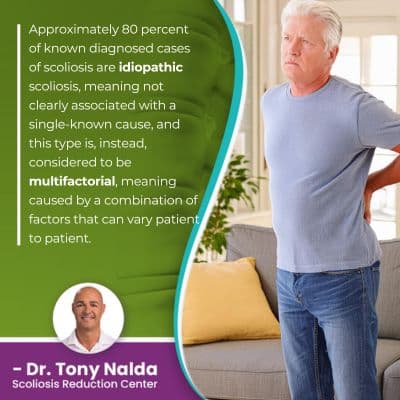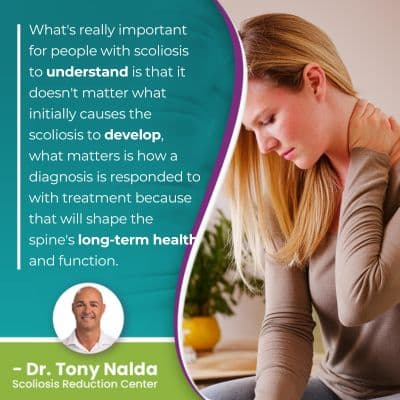What Causes Scoliosis? Everything You Need to Know

While we don't always know what causes scoliosis, we do understand what triggers it to progress: growth. Childhood scoliosis needs to be taken very seriously because rapid and unpredictable growth spurts can cause rapid-phase progression. What you really need to know about scoliosis is that the sooner treatment is started, the better, regardless of a condition's cause.
Scoliosis has different causes based on the condition type in question. The majority of scoliosis cases are classified as idiopathic scoliosis, meaning cause unknown, and the remaining types are associated with known causes: neuromuscular, degenerative, or congenital.
Part of diagnosing scoliosis involves classifying conditions based on important variables, one of which is condition type, and this is determined by a condition's underlying cause.
Table of Contents
What is Scoliosis?
Scoliosis involves the development of an unnatural and unhealthy spinal curvature.
A healthy spine is curved at each of its main sections, which is why it appears straight when viewed from the front and/or back, but will take on a soft 'S' shape when viewed from the sides.
Scoliosis causes the spine to bend unnaturally to the side and twist, making it a 3-dimensional spinal condition that sets it apart from other spinal conditions that cause a loss of its healthy curves.
Current estimates have close to seven million people living with scoliosis in the United States alone, and as the leading spinal condition among school-aged children, awareness is important.
While there are never treatment guarantees, early detection and intervention are associated with treatment success, but that will depend on how a patient's chosen treatment approach responds to a diagnosis: by watching and waiting or treating proactively.
Scoliosis is Progressive
A very important condition characteristic to understand about scoliosis is that it's progressive, meaning its nature is to get worse over time.
 So where a scoliosis is when it's diagnosed doesn't mean that's where it will stay; only treatment can counteract the condition's progressive nature.
So where a scoliosis is when it's diagnosed doesn't mean that's where it will stay; only treatment can counteract the condition's progressive nature.
All types of scoliosis are progressive, regardless of their underlying cause, and scoliosis progressing means the size of the unnatural spinal curve is increasing, and this makes it more complex to treat.
As scoliosis progresses, the spine gets increasingly rigid, making it less flexible and responsive to treatment and making it difficult for some patients to perform key therapeutic exercises as part of treatment.
Scoliosis ranges in severity from mild scoliosis to moderate scoliosis and severe to very severe scoliosis.
Some types of scoliosis are typical with right-bending curves, while others have left-bending curves and are considered atypical.
Different Types of Scoliosis and Their Causes
As mentioned, condition type is determined by causation, and in order to diagnose scoliosis, type has to be determined by a condition's underlying cause.
Approximately 80 percent of known diagnosed cases of scoliosis are idiopathic scoliosis, meaning not clearly associated with a single-known cause, and this type is, instead, considered to be multifactorial, meaning caused by a combination of factors that can vary patient to patient.
Many years have been spent trying to prove the genetic nature of idiopathic scoliosis, but a single gene, or genetic combination, to account for the development of idiopathic scoliosis has yet to be identified, but then why is having a family history of scoliosis considered a risk factor?
Scoliosis can run in families, and this is thought to reflect the condition's multifactorial nature; after all, families share a lot more than just their genes.
Families share responses to stress, posture, body type, diet, lifestyle, socioeconomic factors, geography and much more, and twin studies support the multifactorial nature of idiopathic scoliosis as there are cases of twins where one twin has scoliosis, while the other does not, despite sharing genetics, and other cases where one twin has one type of scoliosis, and the other has a completely different type.
After idiopathic scoliosis, the remaining 20 percent of known cases are associated with known causes: neuromuscular scoliosis, degenerative scoliosis, and congenital scoliosis.
Neuromuscular Scoliosis
Cases of neuromuscular scoliosis (NMS) are caused by the presence of a larger neuromuscular condition such as spina bifida, muscular dystrophy, and cerebral palsy.
In these types of cases, the scoliosis develops as a complication of a larger medical condition, and neuromuscular conditions cause a disconnect between the brain, the muscles, and the connective tissues that support the spine.
The severity is determined by the degree of nerve and muscle involvement, and generally, neuromuscular scoliosis is the most severe type, with some patients ending up in wheelchairs and unable to walk on their own.
In typical cases of idiopathic scoliosis, curves bend to the right, away from the heart, but in atypical cases, like NMS, curves can bend to the left, towards the heart, and this complicates the treatment process and indicates an underlying pathology.
Degenerative Scoliosis
Degenerative scoliosis affects older adults and is caused by natural age-related spinal degeneration, and the cumulative effect of certain lifestyle factors can also play a role in a person's rate and level of degenerative changes.
Carrying excess weight, leading a sedentary lifestyle, chronic poor posture, repeatedly lifting heavy objects incorrectly, and excessive consumption of alcohol and/or smoking can all impact spinal health.
In most cases of spinal degeneration, it's the intervertebral discs that are the first structures to feel the effects, and as a disc sits between adjacent vertebrae that attach to the disc for structural support, if the disc changes shape, it can disrupt the position of nearby vertebrae.
If a disc becomes desiccated (excessive fluid loss), it tends to lose height, impacting the surrounding nerves and vertebral bodies, and making it difficult for the spine to maintain its natural and healthy curves.
Congenital Scoliosis
Congenital scoliosis is caused by a malformed spine that develops in utero, so babies are born with the rare condition, affecting approximately 1 in 10,000.
 A malformed spine can involve vertebrae being misshapen and more triangular in shape than rectangular, making it difficult for vertebrae to remain aligned and on top of one another, and vertebral bodies can also fail to form into distinct and separate vertebral bodies, instead becoming fused together as one solid bone and causing the spine to wedge forward unnaturally.
A malformed spine can involve vertebrae being misshapen and more triangular in shape than rectangular, making it difficult for vertebrae to remain aligned and on top of one another, and vertebral bodies can also fail to form into distinct and separate vertebral bodies, instead becoming fused together as one solid bone and causing the spine to wedge forward unnaturally.
Congenital scoliosis cases need to be comprehensively assessed because babies often present with additional congenital abnormalities.
Treatment options for congenital scoliosis will be different based on each case and how conditions respond to growth.
Scoliosis Treatment and Causation
What's really important for people with scoliosis to understand is that it doesn't matter what initially causes the scoliosis to develop, what matters is how a diagnosis is responded to with treatment because that will shape the spine's long-term health and function.
There are never treatment guarantees, but particularly with early detection and intervention, there are fewer limits to what can be achieved with treatment, and this is because scoliosis can be highly treatable.
Patients can choose between surgical or nonsurgical treatment, and spinal fusion surgery can straighten a bent spine, but it can also cost the spine in many ways that can shape a person's quality of life.
Nonsurgical conservative scoliosis treatment is what patients of the Scoliosis Reduction Center benefit from, and
Conclusion
The main cause of scoliosis is unknown: idiopathic scoliosis. Scoliosis types with known causes are neuromuscular scoliosis, degenerative scoliosis, and congenital scoliosis.
Neuromuscular scoliosis is caused by the presence of a larger neuromuscular condition, and scoliosis develops as a related complication.
Degenerative scoliosis is caused by natural age-related spinal degeneration so affects older adults, and congenital scoliosis is caused by a malformed spine that develops in utero.
In order to be treated effectively, a condition's underlying cause, when known, has to be addressed.
When it comes to understanding scoliosis, I want patients to know that while we don't fully understand what causes most cases of scoliosis to develop initially, we do know what triggers them to progress, and we do know how to treat them effectively.
When scoliosis is treated proactively and treatment is started as close to the time of diagnosis as possible, it can be impacted early in the condition's progressive line, when it's going to be the most responsive.
Scoliosis gets more complex as it progresses, so starting treatment early is associated with treatment success, and regardless of what causes scoliosis, all types are progressive, so the best time to start treatment is always now.
Scoliosis in children should always be taken seriously because progression is triggered by growth, so the more growth a patient has yet to go through, the more potential progression they also have to go through.
While there is no known way to prevent scoliosis from developing, we do know how to respond proactively to a diagnosis and manage conditions effectively.
Dr. Tony Nalda
DOCTOR OF CHIROPRACTIC
After receiving an undergraduate degree in psychology and his Doctorate of Chiropractic from Life University, Dr. Nalda settled in Celebration, Florida and proceeded to build one of Central Florida’s most successful chiropractic clinics.
His experience with patients suffering from scoliosis, and the confusion and frustration they faced, led him to seek a specialty in scoliosis care. In 2006 he completed his Intensive Care Certification from CLEAR Institute, a leading scoliosis educational and certification center.
About Dr. Tony Nalda
 Ready to explore scoliosis treatment? Contact Us Now
Ready to explore scoliosis treatment? Contact Us Now





